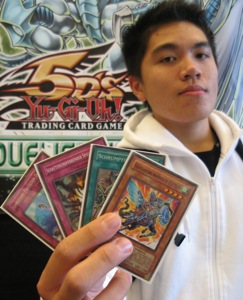It’s no secret: Gladiator Beast players were hugely disappointed with the deck’s flop performance at Shonen Jump Championship Tulsa. I myself was surprised: with so many tech options and new directions available to them, I tentatively expected Gladiator Beasts to take the Championship last weekend. But no one really took those big opportunities: even Chris Bryson’s deck (the only one to make Day 2) was a tired dinosaur compared to what it could have been. In order to survive, Gladiator Beasts will need to evolve and adapt.
Today, that’s exactly what Eric Ing has done with them. Here’s his build.
If you’re reading this coverage live you won’t be able to see Ing’s decklist, so you won’t know what exactly makes it so different. Let me paint you a picture.
 Ten Gladiator Beasts total — not a huge number, but enough to help Gladiator Beast War Chariot be consistent. To protect them, two copies of Shrink, two Book of Moon, an Enemy Controller, two Compulsory Evacuation Device, two Shadow-Imprisoning Mirror, and Mirror Force. The ubiquitous three Solemn Judgment tie the trap lineup together, making for a defensive engine that maintains field presence and slows the duel down. That’s the key: slowing the match and rebuking an opposing TeleDAD player’s complicated moves with fast and simple ones that you can make, then move on from without skipping a beat.
Ten Gladiator Beasts total — not a huge number, but enough to help Gladiator Beast War Chariot be consistent. To protect them, two copies of Shrink, two Book of Moon, an Enemy Controller, two Compulsory Evacuation Device, two Shadow-Imprisoning Mirror, and Mirror Force. The ubiquitous three Solemn Judgment tie the trap lineup together, making for a defensive engine that maintains field presence and slows the duel down. That’s the key: slowing the match and rebuking an opposing TeleDAD player’s complicated moves with fast and simple ones that you can make, then move on from without skipping a beat.
This deck is huge on defense, and once it’s weathered a flurry of Synchro monsters it can control the duel with three Cold Wave and Giant Trunade. Shrink, Book of Moon, Enemy Controller, and Evacuation Device transition from defensive one-shot tricks to attack-enabling weapons; once this deck shifts gears it’s hard to stop. Ing can maneuver himself into a perfect position to take advantage of TeleDAD’s usual play patterns, and once he’s ready to pounce he can adapt his strategy accordingly.
The sacrifices he’s made to fit all these cards into the build are significant. Ing runs just two copies of Elemental Hero Prisma, and no Elemental Hero Stratos. The latter was a card that was largely brought into the Gladiator Beast archetype for the mirror match in the first place, and now that the deck is both slower, and less frequently seen in big tournaments, it’s just not as important. Beyond that loss Ing is slim on one-off monster cards: playing two D.D. Crow and Morphing Jar leaves no room for Breaker the Magical Warrior, Neo-Spacian Grand Mole, Sangan, or other choices that were previously very popular.
The Gladiator lineup itself is noteworthy. Ing is running two copies of the usual suspects (Gladiator Beast Bestiari, Gladiator Beast Laquari, and Gladiator Beast Darius) as well as one copy each of Gladiator Beast Equeste, Hoplomus, Murmillo, and Secutor. The Secutor, which was eschewed by many players at the last two Shonen Jump Championships, is integral here to the long game, in which it makes for easy summons of the all-important Gladiator Beast Heraklinos. The use of all these lower-ATK Gladiators is excused by the face that Ing is playing Shrink, Book of Moon, and Enemy Controller, all of which can make up for those low ATK points.
There are plenty of options for Gladiator Beasts moving forward, and not all of them are represented here: Jutte Fighter, Phoenix Wing Wind Blast, and other choices simply wouldn’t fit. There’s too much stuff to do. Ing has done a great job choosing a selection of top picks that play together to create a sum greater than their individual parts, and while there is no definitive “right” build for Gladiators at the moment, I think this is what the deck needs to do. Splashing individual tech picks won’t cut it — those choices need to share synergy between them for this deck to compete, and that’s what Ing has accomplished here.
Win or lose here today, Ing’s build deserves a lot of attention. In my mind, this is the first real “second generation” Gladiator deck we’ve seen, and hopefully Ing’s performance can set a trend for the coming months. Gladiator Beasts aren’t necessarily over yet, and builds like these are the future for the archetype.